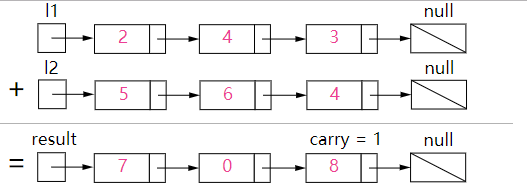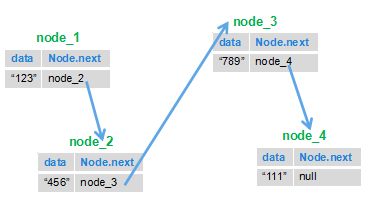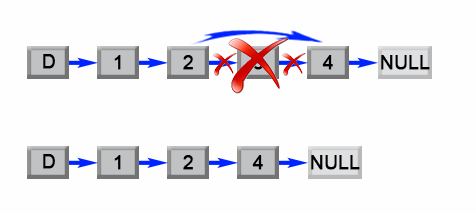mirror of
https://github.com/Snailclimb/JavaGuide
synced 2025-06-16 18:10:13 +08:00
422 lines
11 KiB
Markdown
422 lines
11 KiB
Markdown
<!-- MarkdownTOC -->
|
||
|
||
- [1. 两数相加](#1-两数相加)
|
||
- [题目描述](#题目描述)
|
||
- [问题分析](#问题分析)
|
||
- [Solution](#solution)
|
||
- [2. 翻转链表](#2-翻转链表)
|
||
- [题目描述](#题目描述-1)
|
||
- [问题分析](#问题分析-1)
|
||
- [Solution](#solution-1)
|
||
- [3. 链表中倒数第k个节点](#3-链表中倒数第k个节点)
|
||
- [题目描述](#题目描述-2)
|
||
- [问题分析](#问题分析-2)
|
||
- [Solution](#solution-2)
|
||
- [4. 删除链表的倒数第N个节点](#4-删除链表的倒数第n个节点)
|
||
- [问题分析](#问题分析-3)
|
||
- [Solution](#solution-3)
|
||
- [5. 合并两个排序的链表](#5-合并两个排序的链表)
|
||
- [题目描述](#题目描述-3)
|
||
- [问题分析](#问题分析-4)
|
||
- [Solution](#solution-4)
|
||
|
||
<!-- /MarkdownTOC -->
|
||
|
||
|
||
# 1. 两数相加
|
||
|
||
### 题目描述
|
||
|
||
> Leetcode:给定两个非空链表来表示两个非负整数。位数按照逆序方式存储,它们的每个节点只存储单个数字。将两数相加返回一个新的链表。
|
||
>
|
||
>你可以假设除了数字 0 之外,这两个数字都不会以零开头。
|
||
|
||
示例:
|
||
|
||
```
|
||
输入:(2 -> 4 -> 3) + (5 -> 6 -> 4)
|
||
输出:7 -> 0 -> 8
|
||
原因:342 + 465 = 807
|
||
```
|
||
|
||
### 问题分析
|
||
|
||
Leetcode官方详细解答地址:
|
||
|
||
https://leetcode-cn.com/problems/add-two-numbers/solution/
|
||
|
||
> 要对头结点进行操作时,考虑创建哑节点dummy,使用dummy->next表示真正的头节点。这样可以避免处理头节点为空的边界问题。
|
||
|
||
我们使用变量来跟踪进位,并从包含最低有效位的表头开始模拟逐
|
||
位相加的过程。
|
||
|
||

|
||
|
||
### Solution
|
||
|
||
**我们首先从最低有效位也就是列表 l1和 l2 的表头开始相加。注意需要考虑到进位的情况!**
|
||
|
||
```java
|
||
/**
|
||
* Definition for singly-linked list.
|
||
* public class ListNode {
|
||
* int val;
|
||
* ListNode next;
|
||
* ListNode(int x) { val = x; }
|
||
* }
|
||
*/
|
||
//https://leetcode-cn.com/problems/add-two-numbers/description/
|
||
class Solution {
|
||
public ListNode addTwoNumbers(ListNode l1, ListNode l2) {
|
||
ListNode dummyHead = new ListNode(0);
|
||
ListNode p = l1, q = l2, curr = dummyHead;
|
||
//carry 表示进位数
|
||
int carry = 0;
|
||
while (p != null || q != null) {
|
||
int x = (p != null) ? p.val : 0;
|
||
int y = (q != null) ? q.val : 0;
|
||
int sum = carry + x + y;
|
||
//进位数
|
||
carry = sum / 10;
|
||
//新节点的数值为sum % 10
|
||
curr.next = new ListNode(sum % 10);
|
||
curr = curr.next;
|
||
if (p != null) p = p.next;
|
||
if (q != null) q = q.next;
|
||
}
|
||
if (carry > 0) {
|
||
curr.next = new ListNode(carry);
|
||
}
|
||
return dummyHead.next;
|
||
}
|
||
}
|
||
```
|
||
|
||
# 2. 翻转链表
|
||
|
||
|
||
### 题目描述
|
||
> 剑指 offer:输入一个链表,反转链表后,输出链表的所有元素。
|
||
|
||

|
||
|
||
### 问题分析
|
||
|
||
这道算法题,说直白点就是:如何让后一个节点指向前一个节点!在下面的代码中定义了一个 next 节点,该节点主要是保存要反转到头的那个节点,防止链表 “断裂”。
|
||
|
||
### Solution
|
||
|
||
|
||
```java
|
||
public class ListNode {
|
||
int val;
|
||
ListNode next = null;
|
||
|
||
ListNode(int val) {
|
||
this.val = val;
|
||
}
|
||
}
|
||
```
|
||
|
||
```java
|
||
/**
|
||
*
|
||
* @author Snailclimb
|
||
* @date 2018年9月19日
|
||
* @Description: TODO
|
||
*/
|
||
public class Solution {
|
||
|
||
public ListNode ReverseList(ListNode head) {
|
||
|
||
ListNode next = null;
|
||
ListNode pre = null;
|
||
|
||
while (head != null) {
|
||
// 保存要反转到头的那个节点
|
||
next = head.next;
|
||
// 要反转的那个节点指向已经反转的上一个节点(备注:第一次反转的时候会指向null)
|
||
head.next = pre;
|
||
// 上一个已经反转到头部的节点
|
||
pre = head;
|
||
// 一直向链表尾走
|
||
head = next;
|
||
}
|
||
return pre;
|
||
}
|
||
|
||
}
|
||
```
|
||
|
||
测试方法:
|
||
|
||
```java
|
||
public static void main(String[] args) {
|
||
|
||
ListNode a = new ListNode(1);
|
||
ListNode b = new ListNode(2);
|
||
ListNode c = new ListNode(3);
|
||
ListNode d = new ListNode(4);
|
||
ListNode e = new ListNode(5);
|
||
a.next = b;
|
||
b.next = c;
|
||
c.next = d;
|
||
d.next = e;
|
||
new Solution().ReverseList(a);
|
||
while (e != null) {
|
||
System.out.println(e.val);
|
||
e = e.next;
|
||
}
|
||
}
|
||
```
|
||
|
||
输出:
|
||
|
||
```
|
||
5
|
||
4
|
||
3
|
||
2
|
||
1
|
||
```
|
||
|
||
# 3. 链表中倒数第k个节点
|
||
|
||
### 题目描述
|
||
|
||
> 剑指offer: 输入一个链表,输出该链表中倒数第k个结点。
|
||
|
||
### 问题分析
|
||
|
||
> **链表中倒数第k个节点也就是正数第(L-K+1)个节点,知道了只一点,这一题基本就没问题!**
|
||
|
||
首先两个节点/指针,一个节点 node1 先开始跑,指针 node1 跑到 k-1 个节点后,另一个节点 node2 开始跑,当 node1 跑到最后时,node2 所指的节点就是倒数第k个节点也就是正数第(L-K+1)个节点。
|
||
|
||
|
||
### Solution
|
||
|
||
```java
|
||
/*
|
||
public class ListNode {
|
||
int val;
|
||
ListNode next = null;
|
||
|
||
ListNode(int val) {
|
||
this.val = val;
|
||
}
|
||
}*/
|
||
|
||
// 时间复杂度O(n),一次遍历即可
|
||
// https://www.nowcoder.com/practice/529d3ae5a407492994ad2a246518148a?tpId=13&tqId=11167&tPage=1&rp=1&ru=/ta/coding-interviews&qru=/ta/coding-interviews/question-ranking
|
||
public class Solution {
|
||
public ListNode FindKthToTail(ListNode head, int k) {
|
||
// 如果链表为空或者k小于等于0
|
||
if (head == null || k <= 0) {
|
||
return null;
|
||
}
|
||
// 声明两个指向头结点的节点
|
||
ListNode node1 = head, node2 = head;
|
||
// 记录节点的个数
|
||
int count = 0;
|
||
// 记录k值,后面要使用
|
||
int index = k;
|
||
// p指针先跑,并且记录节点数,当node1节点跑了k-1个节点后,node2节点开始跑,
|
||
// 当node1节点跑到最后时,node2节点所指的节点就是倒数第k个节点
|
||
while (node1 != null) {
|
||
node1 = node1.next;
|
||
count++;
|
||
if (k < 1 && node1 != null) {
|
||
node2 = node2.next;
|
||
}
|
||
k--;
|
||
}
|
||
// 如果节点个数小于所求的倒数第k个节点,则返回空
|
||
if (count < index)
|
||
return null;
|
||
return node2;
|
||
|
||
}
|
||
}
|
||
```
|
||
|
||
|
||
# 4. 删除链表的倒数第N个节点
|
||
|
||
|
||
> Leetcode:给定一个链表,删除链表的倒数第 n 个节点,并且返回链表的头结点。
|
||
|
||
**示例:**
|
||
|
||
```
|
||
给定一个链表: 1->2->3->4->5, 和 n = 2.
|
||
|
||
当删除了倒数第二个节点后,链表变为 1->2->3->5.
|
||
|
||
```
|
||
|
||
**说明:**
|
||
|
||
给定的 n 保证是有效的。
|
||
|
||
**进阶:**
|
||
|
||
你能尝试使用一趟扫描实现吗?
|
||
|
||
该题在 leetcode 上有详细解答,具体可参考 Leetcode.
|
||
|
||
### 问题分析
|
||
|
||
|
||
我们注意到这个问题可以容易地简化成另一个问题:删除从列表开头数起的第 (L - n + 1)个结点,其中 L是列表的长度。只要我们找到列表的长度 L,这个问题就很容易解决。
|
||
|
||

|
||
|
||
### Solution
|
||
|
||
**两次遍历法**
|
||
|
||
首先我们将添加一个 **哑结点** 作为辅助,该结点位于列表头部。哑结点用来简化某些极端情况,例如列表中只含有一个结点,或需要删除列表的头部。在第一次遍历中,我们找出列表的长度 L。然后设置一个指向哑结点的指针,并移动它遍历列表,直至它到达第 (L - n) 个结点那里。**我们把第 (L - n)个结点的 next 指针重新链接至第 (L - n + 2)个结点,完成这个算法。**
|
||
|
||
```java
|
||
/**
|
||
* Definition for singly-linked list.
|
||
* public class ListNode {
|
||
* int val;
|
||
* ListNode next;
|
||
* ListNode(int x) { val = x; }
|
||
* }
|
||
*/
|
||
// https://leetcode-cn.com/problems/remove-nth-node-from-end-of-list/description/
|
||
public class Solution {
|
||
public ListNode removeNthFromEnd(ListNode head, int n) {
|
||
// 哑结点,哑结点用来简化某些极端情况,例如列表中只含有一个结点,或需要删除列表的头部
|
||
ListNode dummy = new ListNode(0);
|
||
// 哑结点指向头结点
|
||
dummy.next = head;
|
||
// 保存链表长度
|
||
int length = 0;
|
||
ListNode len = head;
|
||
while (len != null) {
|
||
length++;
|
||
len = len.next;
|
||
}
|
||
length = length - n;
|
||
ListNode target = dummy;
|
||
// 找到 L-n 位置的节点
|
||
while (length > 0) {
|
||
target = target.next;
|
||
length--;
|
||
}
|
||
// 把第 (L - n)个结点的 next 指针重新链接至第 (L - n + 2)个结点
|
||
target.next = target.next.next;
|
||
return dummy.next;
|
||
}
|
||
}
|
||
```
|
||
|
||
**复杂度分析:**
|
||
|
||
- **时间复杂度 O(L)** :该算法对列表进行了两次遍历,首先计算了列表的长度 LL 其次找到第 (L - n)(L−n) 个结点。 操作执行了 2L-n2L−n 步,时间复杂度为 O(L)O(L)。
|
||
- **空间复杂度 O(1)** :我们只用了常量级的额外空间。
|
||
|
||
|
||
|
||
**进阶——一次遍历法:**
|
||
|
||
|
||
> **链表中倒数第N个节点也就是正数第(L-N+1)个节点。
|
||
|
||
其实这种方法就和我们上面第四题找“链表中倒数第k个节点”所用的思想是一样的。**基本思路就是:** 定义两个节点 node1、node2;node1 节点先跑,node1节点 跑到第 n+1 个节点的时候,node2 节点开始跑.当node1 节点跑到最后一个节点时,node2 节点所在的位置就是第 (L-n ) 个节点(L代表总链表长度,也就是倒数第 n+1 个节点)
|
||
|
||
```java
|
||
/**
|
||
* Definition for singly-linked list.
|
||
* public class ListNode {
|
||
* int val;
|
||
* ListNode next;
|
||
* ListNode(int x) { val = x; }
|
||
* }
|
||
*/
|
||
public class Solution {
|
||
public ListNode removeNthFromEnd(ListNode head, int n) {
|
||
|
||
ListNode dummy = new ListNode(0);
|
||
dummy.next = head;
|
||
// 声明两个指向头结点的节点
|
||
ListNode node1 = dummy, node2 = dummy;
|
||
|
||
// node1 节点先跑,node1节点 跑到第 n 个节点的时候,node2 节点开始跑
|
||
// 当node1 节点跑到最后一个节点时,node2 节点所在的位置就是第 (L-n ) 个节点,也就是倒数第 n+1(L代表总链表长度)
|
||
while (node1 != null) {
|
||
node1 = node1.next;
|
||
if (n < 1 && node1 != null) {
|
||
node2 = node2.next;
|
||
}
|
||
n--;
|
||
}
|
||
|
||
node2.next = node2.next.next;
|
||
|
||
return dummy.next;
|
||
|
||
}
|
||
}
|
||
```
|
||
|
||
|
||
|
||
|
||
|
||
# 5. 合并两个排序的链表
|
||
|
||
### 题目描述
|
||
|
||
> 剑指offer:输入两个单调递增的链表,输出两个链表合成后的链表,当然我们需要合成后的链表满足单调不减规则。
|
||
|
||
### 问题分析
|
||
|
||
我们可以这样分析:
|
||
|
||
1. 假设我们有两个链表 A,B;
|
||
2. A的头节点A1的值与B的头结点B1的值比较,假设A1小,则A1为头节点;
|
||
3. A2再和B1比较,假设B1小,则,A1指向B1;
|
||
4. A2再和B2比较
|
||
就这样循环往复就行了,应该还算好理解。
|
||
|
||
考虑通过递归的方式实现!
|
||
|
||
### Solution
|
||
|
||
**递归版本:**
|
||
|
||
```java
|
||
/*
|
||
public class ListNode {
|
||
int val;
|
||
ListNode next = null;
|
||
|
||
ListNode(int val) {
|
||
this.val = val;
|
||
}
|
||
}*/
|
||
//https://www.nowcoder.com/practice/d8b6b4358f774294a89de2a6ac4d9337?tpId=13&tqId=11169&tPage=1&rp=1&ru=/ta/coding-interviews&qru=/ta/coding-interviews/question-ranking
|
||
public class Solution {
|
||
public ListNode Merge(ListNode list1,ListNode list2) {
|
||
if(list1 == null){
|
||
return list2;
|
||
}
|
||
if(list2 == null){
|
||
return list1;
|
||
}
|
||
if(list1.val <= list2.val){
|
||
list1.next = Merge(list1.next, list2);
|
||
return list1;
|
||
}else{
|
||
list2.next = Merge(list1, list2.next);
|
||
return list2;
|
||
}
|
||
}
|
||
}
|
||
```
|
||
|